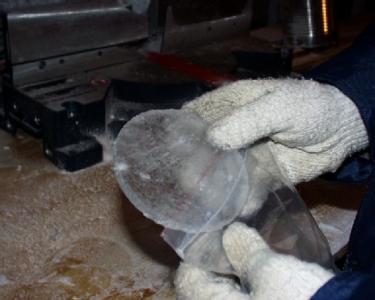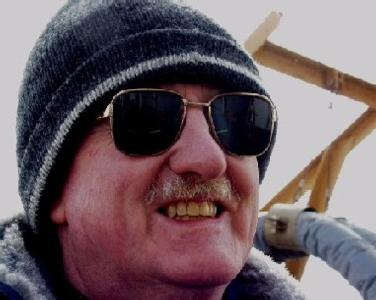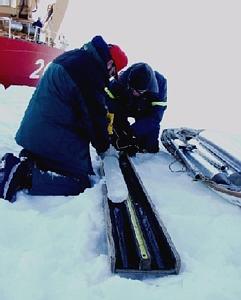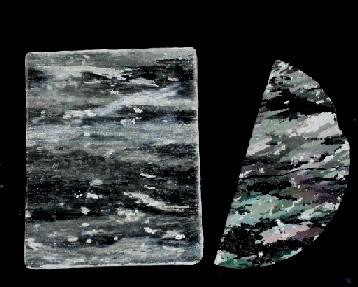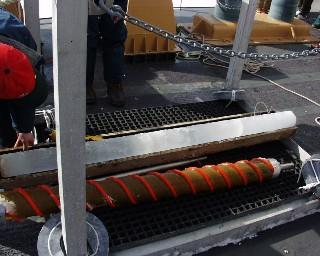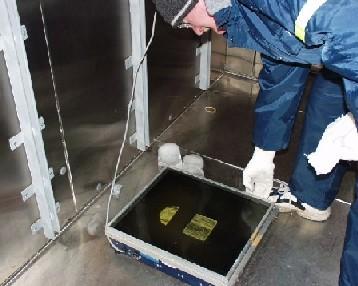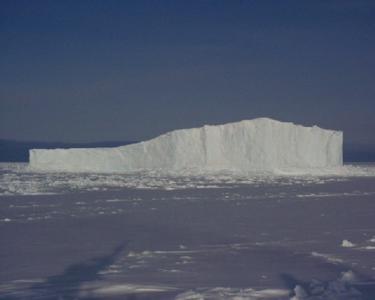
|
7 May, 2000Determining Ice Strength DRAFT May 7, 2000 Daily Data (20:30): Lat. 6830.795301N Long. 06201.44825W Heading 80.809 Air Temp. -11.35C 11.57F True Wind Dir. Calm True Wind Speed Calm USCGC Healy Facts: Science Labs: Main, Wet, Bio-Chem, Electronics, Meteorological, Photography Inuit Language Lesson from Stevie Audlakiak: Taulemaut (taw lee’ mun): Five (Note: Because they communicate in local dialects, neither Stevie nor James knows the words from six to ten in the Inuit Language.) Kojamamek (koo yah’ na ming): Thank you Dear Everyone, >From late morning ice profiling teams on the floe to late afternoon helicopter reconnaissance, from seals and Bow Head whales to thousands upon thousands of Puffins, my Sunday was a National Geographic day. I am always in awe of the indescribable beauty of the Arctic. Stevie Audlakiak has invited me to Broughton Island as a client, of course. Due to its isolation, supplies on Broughton Island are extremely expensive and challenging to obtain. He says he will build me a snow house to sleep in and transport me with his sled and team of 14 Huskies. I can wear the clothes his mother and mother-in-law made for his clients and "keep very warm" he tells me. Polar Bear pants, seal skin parka and boots, caribou parka and pants are available. I must see the beautiful aurora borealis, Stevie insists. I can go fishing and hunting. Stevie works year-round outfitting and guiding. I'm smiling. Do I have an addition to my Dream List? How does the strength of ice relate to the USCGC Healy? Why is this information important to the ice trials of this new vessel? In order to describe the operational characteristics of the Healy, the strength of the ice is essential information. The ice trials of the Healy address this question: Can the Healy break 4 ˝ feet of ice that has a strength of 100 psi (pounds per square inch) at a continuous speed of 3 knots? How is the strength of ice determined? Three measurements need to be taken to determine the flexural (bending) strength of ice: salinity, temperature and density. The temperature is taken immediately after the ice core is obtained on the ice floe. How is this done? A small hole is drilled into the ice core every 10 cm. with a thermometer being placed into each hole for a reading. The data is recorded. The ice core is then taken to the ship's cold room (temperature is maintained at -10C for working with ice cores) where this core is measured and sliced every 10 cm. with electric saws. Each 10-cm. piece is measured for exact length and diameter and its volume is then calculated. Next it is weighed. Once the weight and volume is obtained, then the density can be determined. All the data is noted. First-year sea ice consists of fresh ice with large pockets of brine. The density can be quite high. Dr. Stephen Jones tells me that on our Healy ice trials the ice density has varied from 0.89 up to 0.95 Mgm^3 (megagrams per meter cubed). Pure water is 1.0 on this scale with seawater being around 1.02 Mgm^3. Each 10-cm. piece of ice is subsequently placed in a numbered container and allowed to melt overnight. When it is melted, the salinity is measured and recorded. How is salinity measured? Salinity is determined by measuring the electrical conductivity of water. Pure water has very low conductivity and seawater has high conductivity. A probe is placed into each container of the melted 10-cm. piece of ice core. A meter reads out the parts per thousand (ppt) of salt in the water. This data is recorded. Definitions and formula from Stephen Jones, Ph.D., National Research Council, St. Johns, Newfoundland, Canada: Crossed polaroids: Polarized sheets, which only allow light that is polarized in one direction to pass through them. By having two sheets placed at right angles, no light will pass through. Brine volume: The amount of liquid salty brine remaining in the ice. Density = weight/volume Brine volume = (density)(salinity)/(-4.7-22.4T-0.63T^2-0.11T^3) T (temperature) is degrees Celsius. Density is Mgm^3. Salinity is ppt (parts per thousand). >From brine volume, strength is determined from an equation developed by the strength of ice and relating it to the brine volume. Flexural strength (bending strength) = 1.76 exponential (-5.88 sq. root of brine volume) There are two methods of taking ice cores from the Healy. One method is by Rapid Core. The theory behind this method is that it may be taken without anyone needing to leave the ship and go onto the ice sheet. The apparatus containing the corer is lowered by crane over the side of the ship onto the ice. It is operated from controls on the ship's deck. When it works well, this core can be taken and returned to the vessel within approximately 30 minutes. The diameter of the Rapid Core is around 7 cm. and the length varies with the thickness of the ice. The second method is by a hand-operated corer that requires personnel to go onto the ice floe to work it. The diameter of the ice core taken using this corer is about 10 cm. Thin sections of ice about 2 mm. thick are cut and viewed using a crossed polaroid light table. Individual grains of the sea ice and the brine pockets can be seen. As I take photos, I have been periodically adding them onto my journals on my Teachers Experiencing Antarctica and the Arctic (TEA) Program web page (../tea_kolbfrontpage.html.) Scroll back once in awhile and you may find some new ones! I was just interrupted to go to the stern to have a look at the largest iceberg we have yet encountered. Roger Provost of Canadian Ice Service tells me that it is classed as a Large Iceberg. Refer to my journal of April 28, 2000, "Beginning With Growlers" to read about this category. What a beauty! We are approaching quite close for beginning the testing of multi-year ice. When I'm in my stateroom working, I always leave the door wide-open. I'm searched out when something of interest occurs. I keep my parka close by, grab the cameras and run. Following you will find data from the Healy's ice core number 33 taken on 05/05/00 at 1843 UTC. Can you calculate the volume, density, brine volume and flexural strength? Best regards, Sandra PS: Due to shipboard technical difficulties as of this afternoon and constraints of email size limitations, I will not be sending photos with my journals until the problem is rectified. I am told this could be a few days. Core 33 5/5/00 Time 1843UTC Degrees Minutes Latitude 68 49 Longitude 63 16 Comments: Total Length cm Air temp -7.5C NO Wind speed or direction
For photos and more: ../tea_kolbfrontpage.html For further information: ../ http://www.uscg.mil./pacarea/healy
Contact the TEA in the field at . If you cannot connect through your browser, copy the TEA's e-mail address in the "To:" line of your favorite e-mail package. |




